Hyundai Tucson: Day/night inside rearview mirror
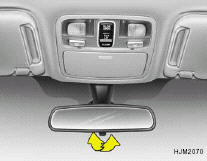 Manual Type
Manual Type
Your Hyundai is equipped with a day/night inside rearview mirror. The "night" position is selected by flipping the tab at the bottom of the mirror toward you. In the "night" position, the glare of headlights of cars behind you is reduced.
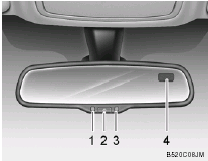 AUTOMATIC DIMMING REAR VIEW MIRROR WITH COMPASS (If installed)
1. Status Indicator LED
2. Feature Control Button
3. Rear Light Sensor
4. Display Window
AUTOMATIC DIMMING REAR VIEW MIRROR WITH COMPASS (If installed)
1. Status Indicator LED
2. Feature Control Button
3. Rear Light Sensor
4. Display Window
Automatic dimming rear view mirror controls automatically the glare of headlights of the car behind you when it turned on by pressing and holding the button for more than 3 but less than 6 seconds. It is turned off by pressing and holding the button for same time once more.
1. To operate Compass feature
Press and release the button, then the vehicle's directional heading will be displayed. Pressing and releasing the button again will turn off the display.
Heading display. - E : East. - W : West. - S : South. - N : North. ex) NE : North East.
2. Calibration procedure
Press and hold the button for more than 9 but less than 12 seconds. When the compass memory is cleared a "C" will appear in the display.
- Driving the vehicle in a circle at less than 5mph 2 times or until the compass heading appears. - Driving in a circle in right-handed direction and opposite direction are possible, and if the calibration is completed, the compass heading will appear. - Keep driving in a circle until a compass heading appears.
3. Setting the compass zone
1. Find your current location and variance zone number on the zone map.
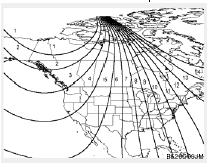
2. Press and hold the button for more than 6 but less than 9 seconds. The current zone number will appear in the display. 3. Press the button until the new zone number appears in the display. After you stop pressing the button in, the display will show a compass direction within a few seconds.
4. Changing Mirror Angle setting (If Installed):
Due to mirror positions being angled towards the driver, the compass mirror can also compensate for drivers seated on the Left Hand side of the vehicle (steering wheel on the LH side of the vehicle) or Right Hand side of the vehicle (steering wheel on the RH side of the vehicle).
To adjust the Left Hand, “L” or Right Hand, “R”, setting: 1. Press and hold the button for more than 12 seconds. 2. Release then press the button to toggle between “L” and “R”.
NOTE: This procedure also causes the compass to be de-calibrated.
3. To re-calibrate the compass, drive the vehicle in 2 complete circles at less than 8km/ h (5mph).
CAUTION: 1. Do not install the ski rack, antenna, etc. which are attached to the vehicle by means of a magnet. They affect the operation of the compass. 2. If the compass deviates from the correct indication soon after repeated adjustment, have the compass checked at an authorized dealer. 3. The compass may not indicate the correct compass point in tunnels or while driving up or down a steep hill. (The compass returns to the correct compass point when the vehicle moves to an area where the geomagnetism is stabilized.) 4. When cleaning the mirror, use a paper towel or similar material dampened with glass cleaner. Do not spray glass cleaner directly on the mirror as that may cause the liquid cleaner to enter the mirror housing.
Parking brake
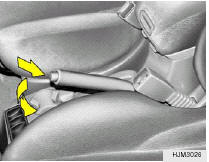 Applying the parking brake
Applying the parking brake
To engage the parking brake, first apply the foot brake and then without pressing the release button in, pull the parking brake lever up as far as possible. In addition it is recommended that when parking the vehicle on a gradient, the shift lever should be positioned in the appropriate low gear on manual transaxle vehicles or in the P (Park) position on automatic transaxle vehicles.
CAUTION: Driving with the parking brake applied will cause excessive brake pad (or lining) and brake rotor wear.
Releasing the parking brake
To release the parking brake, first apply the foot brake and pull the parking brake lever slightly. Secondly, depress the release button and lower the parking brake lever while holding the button.
Tail gate
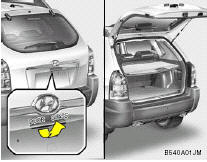
o Pull and raise the "DOOR" release lever to open the tail gate. o To close, lower the door, then press down on it until it locks. To be sure the door is securely fastened, try to pull it up again.
WARNING: The tail gate should always be kept completely closed while the vehicle is in motion. If it is left open or ajar, poisonous exhaust gases may enter the car resulting in serious illness or death to the occupants. See additional warnings concerning exhaust gases.
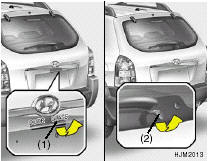 Tail gate Window
Tail gate Window
o Pull the "GLASS" release lever (1) to open the tailgate window glass, and raise the window open lever (2). o To close the tail gate window, lower the tail gate window, and it will close by itself. To be sure the tail gate window is securely fastened, try to pull it up again.
NOTE: The tail gate window lock is operated in connection with the tail gate lock. To open the tail gate window make sure the tailgate is unlocked with a key or the central door locking switch.
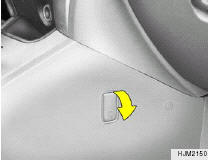 SHOPPING BAG HOLDERS (If installed)
SHOPPING BAG HOLDERS (If installed)
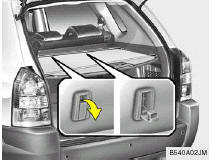
Shopping bag holders are located in the front console and on the backside of the rear seat. When not in use, return it to the original position.
CAUTION: o Do not hang a bag beyond 6 Ibs (3 kg). It may cause damage to the shopping bag holder. o Return it to the original position after using the shopping bag holder.
Luggage compartment
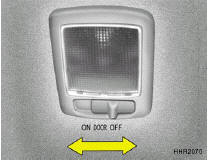 LUGGAGE COMPARTMENT LIGHT (If installed)
LUGGAGE COMPARTMENT LIGHT (If installed)
Luggage compartment light has a 3-position switch. The three positions are: o In the "DOOR" position, the luggage compartment light comes on when the tail gate is opened, then goes out when it is closed. o In the "ON" position, the light stays on at all times. o In the "OFF" position, the light stays off at all times.
See also:
Running-in recommendations
During the running-in period for the first 1,000 km (600 miles), it is advisable
to drive your new vehicle using the following precautions as a guideline to aid
long life as well as future economy and performance.
● Do not race the engi ...
Driving when tired or sleepy
When you are tired or sleepy, your
reaction time will be delayed and
your perception, judgment and attentiveness
will be impaired. If you
drive when tired or sleepy, your,
your passengers’ and other persons’
chances of being invol ...

 Outside rearview mirror
Outside rearview mirror